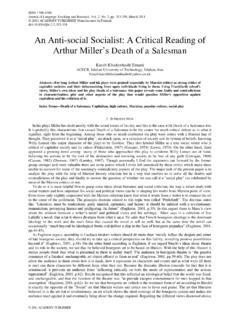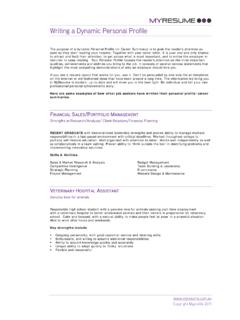Transcription of An Analytical Rubric for Assessing Creativity in Creative ...
1 An Analytical Rubric for Assessing Creativity in Creative writing Hamideh Mozaffari English Department, Guilan University, Rasht, Iran Abstract Assessment is a crucial component of teaching Creative writing . However, the discipline lags far behind its composition and literary counterparts to develop a plausible method for evaluating Creativity . Therefore, after reviewing the past and current literature on the topic, this study describes the design and implementation of an Analytical Rubric which encompasses four major qualities of Creative language (image, characterization, voice and story). The reliability and validity of the proposed Rubric are also empirically evaluated. The result reveals that the Rubric provides the sufficient reliability and validity value reported in the literature for rubrics.
2 Besides, the article includes some sample analyses to explicate its application. Index Terms Creative writing , assessment, Analytical Rubric I. INTRODUCTION Assessment is the primary concern of all educational settings. Marks provide students with significant information about their performance and progress and further enable outsiders to make decisions based on students' qualifications (Harmer, 2007). However, it is not without limitations. Many assessment techniques lack sufficient validity and reliability (Baer & McKool, 2009) and low marks might lead to low self-esteem and subsequently discourage students (Kroll, 1997). Theses pros and cons would intensify in evaluating Creative writing since "here students produce and are therefore in charge of the content to some degree; they are personally involved in what comes from their own imagination.
3 Teachers also function as individual readers with their own tastes and prejudices" (Kroll, 1997, p. 1). The question of whether Creative writing can be assessed or not is hotly debated. The argument rests on the common misconception that subjective criteria (teachers' likes and dislikes) are the sole source of estimating Creativity in a piece of writing (Kantor, 1972; Newman, 2007). The idea is so influential that Carey (2005), like many others, posits that "the evaluation of works of art is purely subjective and thus cannot be codified" (p. 52 as cited in Newman, 2007). In contrast, May (2007) criticizes the assumption and argues that to objectify evaluation teachers should endeavor to set standard criteria for evaluating Creative works. Rubrics or grading grids are the best ways to ensure objectivity in Creativity assessment (Blomer, 2011).
4 However, the discipline heavily suffers from such standards as Newman (2007) maintains " Creative writing courses do not have as yet the explicit national standards or benchmarks for assessment that have been compiled for many other long-established subjects" (p. 26). Thus, the present study attempts to develop an assessment Rubric which encompasses the major qualities of Creative language. II. LITERATURE REVIEW Assessment is one of the most challenging parts of teaching Creative writing (Kator, 1972; England, 2009). Literature reveals that methods of Creativity assessment are either based on a specific theory of Creativity (such as divergent thinking theory as in divergent thinking tests), attributes theoretically linked to Creativity (such as originality, voice, etc.)
5 As in rubrics) or judgment of experts of the field (as in consensual assessment technique). In what follows we provide a brief explanation on each of these methods. A. Assessment Techniques Based on Theories of Creativity One of the most widely used theories of Creativity is divergent thinking. In fact, it is an idea generation technique (such as brainstorming) which seeks possible ways to generate various ideas about something (Richards & Schmidt, 2002). The concept is so influential that Silvia (2008), like many others, posits that Creative thinking necessitates divergent thinking. Accordingly, various tests have been developed to assess Creativity based on this concept. However, most divergent thinking tests (Torrance Test of Creative Thinking, Verbal Creativity Test, etc.
6 Are based on the question of how many uses one can imagine for various objects and therefore lack sufficient validity for evaluating Creativity in domains such as writing (Baer & Mckool, 2009). B. Consensual Assessment Technique Primarily employed in research settings, consensual assessment technique is a new method for Assessing Creativity in which a group of experts rate the Creativity of products such as a theory, research design, story, painting, etc. In fact, judges are not required to follow any specific set of standards that is, evaluation is primarily based on their expert knowledge of Creativity in a specific domain. Despite the fact that this method benefits from high degrees of validity, it ISSN 1799-2591 Theory and Practice in Language Studies, Vol.
7 3, No. 12, pp. 2214-2219, December 2013 2013 ACADEMY PUBLISHER Manufactured in 2013 ACADEMY PUBLISHERhas two major drawbacks: (a) It is highly resource intensive since it requires an average panel of 10 expert judges, and (b) it is based on subjective judgment of experts who rely on their sense of what is Creative in a specific domain to rate Creativity (Baer & Mckool, 2009). C. Assessment Techniques Based on Attributes of Creativity Rubrics are one of the major tools for Assessing writing which incorporate a set of prominent characteristics relevant to a specific type of discourse (Weigle, 2002). Several rubrics have been developed to evaluate Creativity in Creative writing . However, they either contain criteria which are too general ( voice is distinctive, work is original, scenes and events are memorable, etc.)
8 , irrelevant to Creativity ( spelling, grammar, punctuation and syntax are correct, organization is clear, etc.) or left some important aspects behind. We look at some of such criteria in the following. Many of the criteria on which the current rubrics are based lack clarity and are therefore hard to measure. Peter (1990, np.), for instance, considers the capacity "to move the audience" as the most crucial criteria for Assessing Creative works. But, how far is it possible to examine the extent to which a piece of writing has moved the audience. Similarly, while Kroll (1997) refers to originality as another quality associates with Creativity , he does not delineate what this originality might involve and how it can be traced in the text. Moreover, the criteria set by most institutions across UK suffer from the same problem as the following assessment guideline reveals: The work will be striking and original; phrases, lines, characters, descriptions, moments, dramatic events or explorations of fictional settings may be eloquent and memorable.
9 The subject-matter of the work will have been explored intelligently, with insight and breadth of viewpoint. An impressive knowledge and understanding of both form and subject-matter will be evident. Creative writing ..will show a clear understanding of the reader s needs and those of genre. ( May, 2007 p. 73) On the other hand, some of the criteria are hardly related to Creativity in language. It is certainly true that qualities such as organization and mechanics are crucial for every piece of writing . However, the criteria set for evaluating writing depend on the purpose one wants to achieve (May, 2007). Since the primary purpose of Creative writing is to achieve Creativity in language, its assessment should focus on such features.
10 Nonetheless, in the guidelines that Saskatchewan (1998) and later NCTE (2004) set for Creativity assessment more than half of the scores is devoted to non- Creative features (mechanics, organization and structure). Moreover, Durham University's (2013) Rubric marks Creative writings for aspects such as tense and conjunctions. This problem has even penetrated assessment at level. Correctness of grammar, vocabulary, syntax and spelling are among the key criteria which Newman (2007) sets out for evaluation of Creative writing . Thus, it can be concluded that validity of Creativity tests for evaluating Creative writing heavily depends on the validity of the theory upon which it is based. However, most theories of Creativity have proved to be invalid for Assessing Creativity in writing (Baer & McKool, 2009).







